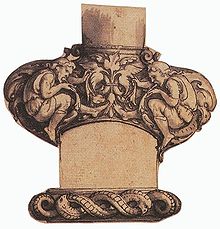- Bollock dagger
-
 Design of a guard for a ballock-dagger with top mount of the scabbard, by Hans Holbein the Younger, c. 1536–38
Design of a guard for a ballock-dagger with top mount of the scabbard, by Hans Holbein the Younger, c. 1536–38
 A set of bollock daggers found on board the 16th century ship Mary Rose. The blades have either completely corroded or remain only in the form of concretions.
A set of bollock daggers found on board the 16th century ship Mary Rose. The blades have either completely corroded or remain only in the form of concretions.
The bollock dagger or ballock knife is a type of dagger with a distinctively shaped shaft, with two oval swellings at the guard resembling male genitalia ("bollocks"). The guard is often in one piece with the wooden grip, and reinforced on top with a shaped metal washer. The dagger was popular in Scandinavia, Flanders, England and Scotland between the 13th and 18th centuries, in particular the Tudor period. In England the bollock dagger was commonly carried by many Border Reivers, as a backup for the lance and the sword. A large number of such weapons were found aboard the wreck of the Mary Rose. In use, the bollock dagger was similar to the Scottish dirk.
In the Victorian period weapon historians introduced the term kidney dagger, due to the two lobes at the guard, which could also be seen as kidney-shaped, in order to avoid any sexual connotation. (Blair 1962).
The hilt was often constructed of box root (dudgeon) in the 16th and 17th centuries, and the dagger was sometimes called dudgeon dagger or dudgeonhafted dagger in this period.
The bollock dagger is the source of the expression, to get, or give, a "bollocking", meaning to give or receive a severe chastisement.[1][not in citation given]
References
- ^ "The Bollock Daggers". Archived from the original on 2007-09-28. http://web.archive.org/web/20070928140501/http://www.interknife.co.uk/shopping/bollockdagger.html. Retrieved 2008-01-28.
- Blair, C. (1962). European and American Arms c. 1100—1800. B. T. Batsford, London.
External links
- Spotlight: The Ballock Dagger (myArmoury.com article)
- Mary Rose Trust
- Interknife - picture of various bollock daggers

This article related to weaponry is a stub. You can help Wikipedia by expanding it.
